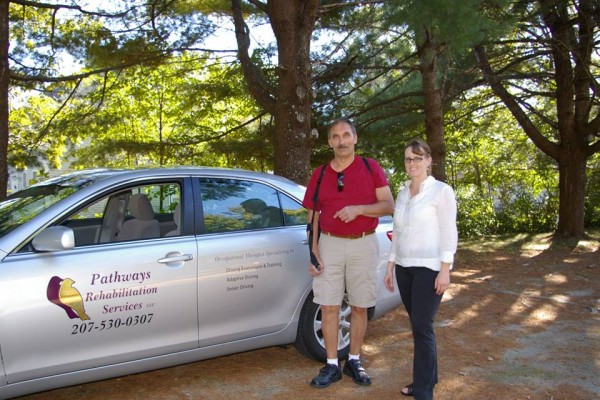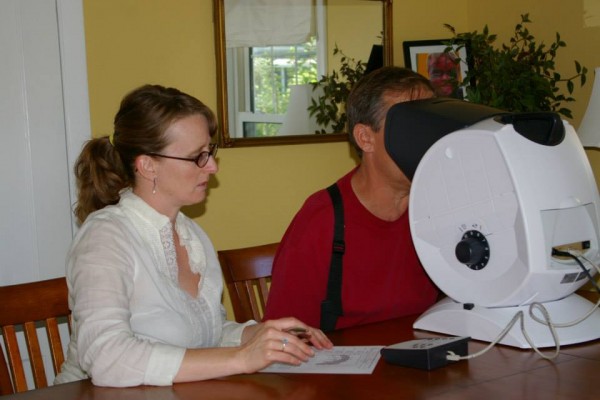Scott Anderson was only 60 when he had a stroke in early 2013. “I was cutting a banana,” he told me when we spoke on the phone recently. “All of a sudden something happened. I tried to say to my wife, ‘I think something’s wrong,’ but I couldn’t say it right.”
His wife called 911 and not long after, Scott was in the local emergency room. He spent a week in the Intensive Care Unit. “I couldn’t talk,” he says. “I couldn’t do anything. I was a mess. It took nine months of speech therapy before I could talk well.”
The entire right side of his body was affected by the stroke. Even after months of rehab, his right arm still doesn’t work as it should. “It’s strong, but still not there yet,” says Scott. “From the wrist down, my fingers have never really moved since my stroke. I can feel them, but I can barely open the refrigerator. I can turn my wrist and hook the refrigerator door in my hand and open the door. That’s about it.”
A little over a year after he had the stroke Scott was feeling especially frustrated by all he couldn’t do. That’s when occupational therapist Heather Shields stepped in and taught him how to drive again. Heather runs a certified driving school called Pathways Driving Rehabilitation Services. Her goal is to help adults and seniors stay mobile and do it safely.
Heather evaluated Scott’s abilities and recommended some adaptive equipment that would help him drive. “He doesn’t have the use of his right arm,” she explains, “but he does have the use of his feet and legs. He had enough control in his ankle that he was able to go from the gas to the brake. Because he only had one arm, it made it difficult for him to steer, so I got an adaptive piece called a spinner knob. It goes on the steering wheel.”
The spinner knob has several buttons on it that control things like the blinkers and windshield wipers. “It has about six different functions on it,” says Heather, “because if you have only one arm it’s hard to steer the car and hit the blinkers and things like that.”
As an occupational therapist and a certified driving rehabilitation specialist and Class B driving instructor, Heather’s an expert at helping people who are impaired in some way learn how to drive again.
“Particularly people with medical conditions like Scott,” she says. “They’ve had so much loss already that being able to drive gives them such freedom and independence. Usually, they’ve been depending on others to help them with so many aspects of their life that once they get to the point where they are able to work with me they are so ready.”
Unlike most driving schools, she does assessments, evaluations, and driver’s education in the client’s home and community. A typical evaluation lasts three to four hours with the driver and family members. It includes a clinical assessment and an on-the-road assessment. Heather begins by asking lots of questions.
- What is the person’s story?
- What are his/her abilities?
- Limitations?
She tests the person’s vision and cognitive skills. “I do different tests,” she explains. “I’m timing them and seeing if they make mistakes. If the person is really slow or making mistakes they can’t fix, I know there are some processing issues and there might be issues out on the road. I also look at their physical abilities — their strength, for instance, or limitations.”
In addition to helping people like Scott who’ve had a stroke or have some other health issue, Heather also often gets calls from concerned family members who are worried that a loved one is no longer safe on the road. After a thorough evaluation, she sometimes decides the person shouldn’t be driving anymore because he/she made too many mistakes.”When that happens,” she says, “I will have a family member with us. We talk about the reasons behind my recommendation. It’s not easy, but I can be the bad guy— someone who is not emotionally connected and is a professional.”
As a follow-up, she’ll research the person’s community and find a variety of transportation options. “So they can still be connected to their community and the people they love,” she explains. “And also, they won’t always have to rely on their family for rides.”
Scott Anderson’s life changed dramatically after his stroke, but he’s thrilled that he can still drive. Heather not only determined he was fit to drive, she also helped him choose the right adaptive equipment. And she took him to get his driver’s license. “I passed because she helped me out,” he says. “I got my license and I’m driving now. I can’t thank her enough.”
Thank you for reading this post about learning to drive again after having a stroke. If you’re interested, you’ll find more information about Pathways Driving Rehabilitation Services on Heather’s website. You can also ask your doctor or physical or occupational therapist about being evaluated by a driver rehabilitation specialist.
Scott probably survived his stroke because his wife called 911 immediately. Would you know the signs and what to do? If you don’t think so, take a moment to read another post I wrote: Strokes kill people we love: Know the risks.
This post was originally written for Advantage Home Care.




Diane Atwood just posted my article last night, 2/6/17, about my recent stroke and gratitude to so many. I then noticed the post about occupational therapist Heather Shields and her Pathways Driving Rehabilitation Services. She was warm, patient, and helpful in my telephone call to her just now about resuming driving and whether I need an evaluation from her. She is another caring professional I now appreciate!
I’m so happy you discovered Heather, Sally. She’s wonderful!